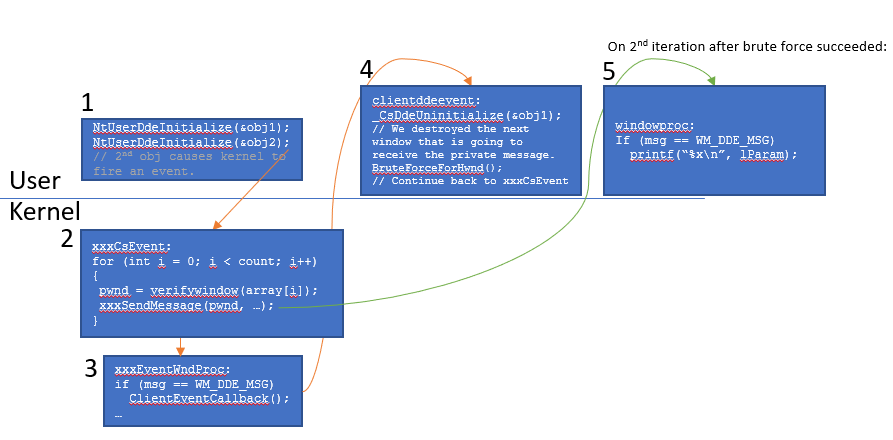Yet another pointer leak in the win32k driver, this time it’s a cool bug. It’s inside the DDE (Dynamic Data Exchange) component.
- It’s possible creating DDE objects (whatever that means) and each gets a corresponding newly created kernel window by using the NtUserDdeInitialize syscall.
- Internally, it adds the new DDE object to a global linked list of all such objects.
- In certain cases, it needs to update all DDE windows that some event occurred by sending them a message (by xxxSendMessage). Alas, this message encodes a kernel heap pointer in the LPARAM argument.
Ah ha, I thought to myself: if I manage to get the message routed to a user-mode window procedure, then the LPARAM will reveal sensitive kernel info. Profit.
Looking at the function xxxCsEvent which is the workhorse of step #3:
- It first converts the linked list into an array of HWNDs (not pointers, but the window-identifier) – Problem #1
- It then walks over the array and verifies the HWND still represents an existing window, and then it sends a DDE message to that window procedure – Problem #2
It looks something like that (which is super simplified):
count = 0;
// Query the list depth.
for (p = g_listHead; p != NULL; p = p->next) count++;
array = malloc(sizeof(HWND) * count);
// Convert the list into an array of handles.
for (i = 0, p = g_listHead; p != NULL; p = p->next, i++)
array[i] = p->pwnd->hwnd;
// Iterate over the array and dispatch.
for (i = 0; i < count; i++)
{
pwnd = verifywindow(array[i]);
if (pwnd != NULL)
xxxSendMessage(pwnd, WM_DDE_MSG, 0, kernel_ptr);
}
The way to attack this algorithm is by understanding that the kernel windows that belong to the DDE objects can be replaced during the first callback to user-mode, so the second iteration (given we created 2 DDE objects) will send a message to a window that we created from user-mode, that has exactly the same HWND (defeating problem #1 and #2), so we get the message directly from kernel, because window verification passes.
Wait, what???
If we could get the message on the first iteration to user-mode, then it's a game over already. The catch is that we can't set a user-mode window-procedure for a kernel DDE window. But we don't need to, as the DDE window procedure (xxxEventWndProc) anyway calls back to user-mode on its own by calling ClientEventCallback. Once we hook that function we're good to get control back to user-mode in the middle of the first iteration.
Now back in user-mode, we can destroy the next iterated DDE object, and it will destroy the corresponding window too, whose HWND we already know.
And now, all we have to do is to brute force to create a window that will have the same HWND, to make the verifywindow() succeed, and then xxxSendMessage sends the raw pointer to us :)
Brute forcing a HWND is very simple, because given the HWND encoding, one has to iterate exactly 16 bits space (hence, loop 0x10000 times) to get the same HWND again (over simplified again, but would work 99% of the cases). Without going into all details.
The following diagram tries to explain the flow that the attacker has to go through in order to exploit described code above:

A POC can be found on github.